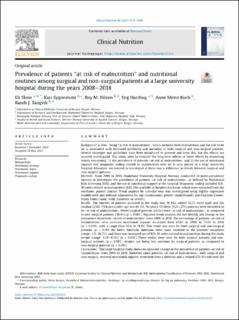| dc.description.abstract | Background & aims: Being “at risk of malnutrition”, which includes both malnutrition and the risk to be so, is associated with increased morbidity and mortality in both surgical and non-surgical patients. Several strategies and guidelines have been introduced to prevent and treat this, but the effects are scarcely investigated. This study aims to evaluate the long-term effects of these efforts by examining trends concerning: 1) the prevalence of patients «at risk of malnutrition» and 2) the use of nutritional support and diagnostic coding related to malnutrition over an 11-year period in a large university hospital. Moreover, we wanted to investigate if there was a difference in trends between surgical and non-surgical patients.
Methods: From 2008 to 2018, Haukeland University Hospital, Norway, conducted 34 point-prevalence surveys to investigate the prevalence of patients «at risk of malnutrition», as defined by Nutritional Risk Screening 2002, and the use of nutritional support at the hospital. Diagnostic coding included ICD-10 codes related to malnutrition (E43, E44 and E46) at hospital discharge, which were extracted from the electronic patient journal. Trend analysis by calendar year was investigated using logistic regression models with and without adjustment for age (continuous), gender (male/female) and Charlson Comorbidity Index (none, mild, moderate or severe).
Results: The number of patients included in the study was 18 933, where 52.1% were male and the median (25th, 75th percentile) age was 65 (51, 76) years. Of these, 5121 (27%) patients were identified to be «at risk of malnutrition». Fewer surgical patients (21.2%) were «at risk of malnutrition», as compared to non-surgical patients (30.9%) (p < 0.001). Adjusted trend analysis did not identify any change in the prevalence of patients «at risk of malnutrition» from 2008 to 2018. The percentage of patients «at risk of malnutrition» who received nutritional support increased from 61.6% in 2008 to 71.9% in 2018 (p < 0.001), with a range from 55.6 to 74.8%. This trend was seen for both surgical and non-surgical patients (p < 0.001 for both). Similarly, dietitians were more involved in the patients’ treatment (range: 3.8–16.7%), and there was increased use of ICD-10 codes related to malnutrition during the study period (range: 13.0–41.8%) (p < 0.001). These trends were seen for both surgical patients and non-surgical patients (p < 0.001), despite use being less common for surgical patients, as compared to non-surgical patients (p < 0.001).
Conclusions: This large hospital study shows no apparent change in the prevalence of patients «at risk of malnutrition» from 2008 to 2018. However, more patients «at risk of malnutrition», both surgical and non-surgical, received nutritional support, treatment from a dietitian and a related ICD-10 code over the study period, indicating improved nutritional routines as a result of the implementation of nutritional guidelines and strategies. | en_US |

